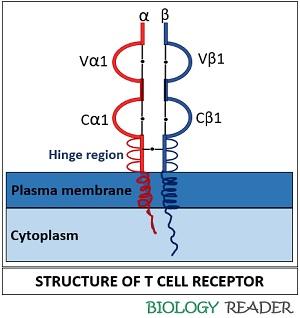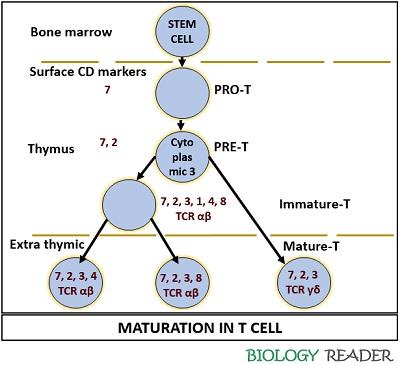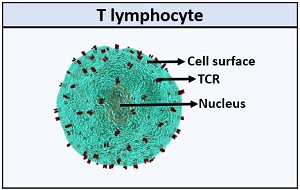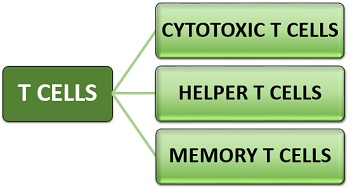T cell or thymus cell lymphocyte is one of the immune cells, which grows in the thymus gland. It performs a significant role in stimulating an adaptive immune response. T lymphocytes are different from the other immune cells in having T-cell receptors or TCRs on their cell surface.
TCRs exist as a heterodimer protein complex responsible for recognizing antigenic fragments. T cells originate from the stem cells of bone marrow as the precursor cells. Eventually, they move into the thymus gland for differentiation or maturation into several distinct types of T.
The differentiated T cells leave the thymus and go into the lymphatic system or peripheral tissues searching for an antigen on the surface of antigen-presenting cells. T cells activate once they encounter specific antigens. Cytotoxic, helper and regulatory T cells are the three common types.
This post describes the definition, three common types and the whole maturation process of T lymphocytes. Also, the meaning and structure of TCRs have been explained.
Content: T Cell
Definition of T Cells
T cells refer to the type of white blood cells, which serve as the essential components of an adaptive immune system. They differentiate into specific helper, regulatory, cytotoxic T cells and later becomes the memory T cells. Thus, T lymphocyte provides various immune-related functions, like antigen recognition, regulation of immune response, stimulates antibodies production of antibodies and cell apoptosis. Millions of T cells possess unique receptors on their surface that act against the specific antigens.
T Lymphocyte Types
It depends upon the cell receptors, functions and the type of antigens encountered. They are broadly categorized into regulatory and effector T lymphocytes based on the presence of co-receptors like CD8+ or CD4+. T lymphocytes differentiate into cytotoxic T cells that possess CD8 surface marker. T cells differentiate into helper T cells that possess a CD4 surface marker.
Cytotoxic T Cells
They refer to the cytolytic or CD8+ T cells that consist of CD8+ surface markers. Cytolytic cells function as killer T cells, which destroy the infected cell. The majority of them express TCRs to recognize the target cell. Antigenic fragments of the APC bind to the MHC Class I molecule.
Then, the specific binding between TCR with the class-I MHC molecules carrying antigen aids antigen-specific activation. They primarily kill target cells by producing cytokines. The target cells include tumour cells, allograft and virus affected cells.
The association of dendritic cells and T helper cells receive a signal to kill the target or infected cell. Therefore, it plays a central role in destroying the cells infected with the virus and the cells infected with intracellular bacteria or tumorous cells.
Helper T Cells
They refer to the CD4+ or inducer T cells that consist of CD4+ surface markers. Inducer T cells mediate immune function or immune responses. The CD4+ cell recognizes a target cell via MHC Class II restriction. They perform diverse functions and differentiate into TH cells (TH 1, TH 2, TH 17) and Treg cells.
- TH 1 releases cytokines, interferons gamma and interleukins-2 that play a vital role in activating macrophages and T-cells. It promotes cell-mediated immunity that destroys the cell infected with intracellular pathogens.
- TH 2 releases cytokines IL-4, 5 and 6 that primarily activate B cells (producing antibodies).
- TH 17 releases cytokines IL-17 that provides immunity against chronic mucocutaneous infections.
- Treg cells are the regulatory T cells that release cytokine TGF beta that regulate the peripheral tolerance of neighbouring cells, immune response and prevents autoimmune responses.
Therefore, the role of CD4 T cells involves activation of nearby immune cells (macrophages and NK cells), releasing cytokines, and helping B cells to stimulate antibodies production. It also monitors humoral and cellular immunity.
Memory T Cells
Memory T cells contain CD4+ or CD8+ as the surface markers. They provide long-lived memory and anamnestic secondary immune response. Memory T cells differentiate into effector T cells after exposure to the particular antigen. They remember the formerly attacked target cell and respond to the past infection.
T Cell Receptor
TCR or T cell receptor is a heterodimer that consists of glycoprotein chains arranged on the cell surface. The glycoprotein chain exists as two pairs, either αβ or ƴδ TCR chains, attached via a disulphide bond. The TCR chains are held near the hinge region of the T cell membrane.

The transmembrane portion of the T cell receptor comprises positive charges and also contains a short cytoplasmic tail. TCR includes variable, diversity, joining and constant encoded regions. Its structure resembles the immunoglobulins, and hence it also functions as an antigen recognition unit.
T Cell Maturation
The haematopoietic stem cell of bone marrow releases multipotent T cell precursors and differentiating them into progenitor T cells. Then, the immature PRO T cells travel to the thymus via the circulatory system for their maturation at the time of the embryonic or postnatal stage.

T lymphocytes undergo a maturation process in the thymus, where most thymocytes are eliminated and destructed in the thymus. Here, the process refers to the thymus selection process.
- When the receptors of thymocytes contact the autoantigens, they can survive in the thymus by receiving positive signals. In the thymus, all the T cells carry receptor molecules on their cell surface known as T cell receptors that are specific for a particular antigen.
- When the TCRs contact with the self-antigens gets eliminated from the repertoire by receiving negative signals.
Then, the T lymphocytes leave the thymus via blood circulation to the peripheral lymphoid organs. Once they encounter a specific antigen, the T lymphocytes get activated and differentiate into an effector or regulatory T cells. The efficiency of the thymus to produce mature T cells involutes as age increases, and a person becomes more susceptible to infections.
Conclusion
Therefore, we can conclude that the T lymphocytes are the small immune cells that perform distinct functions in our immune system. When a cell encounters an antigen, the helper T cell stimulates the secretion of cytokines. The release of cytokines stimulates the antibody production by the plasma cells.
Regulatory T cells control immune reactions, and cytotoxic T cells (activated by various cytokines) kill the infected or tumorous cells. Memory T lymphocytes remember the infection site and provide an instant secondary response to the re-exposure of that antigen.


I really appreciate your article, keep up the good work buddy. These tips are very helpful, and i do think it is a good way to reach consumers. It does give a new insight in success. Thank you for sharing this, Have a nice day!